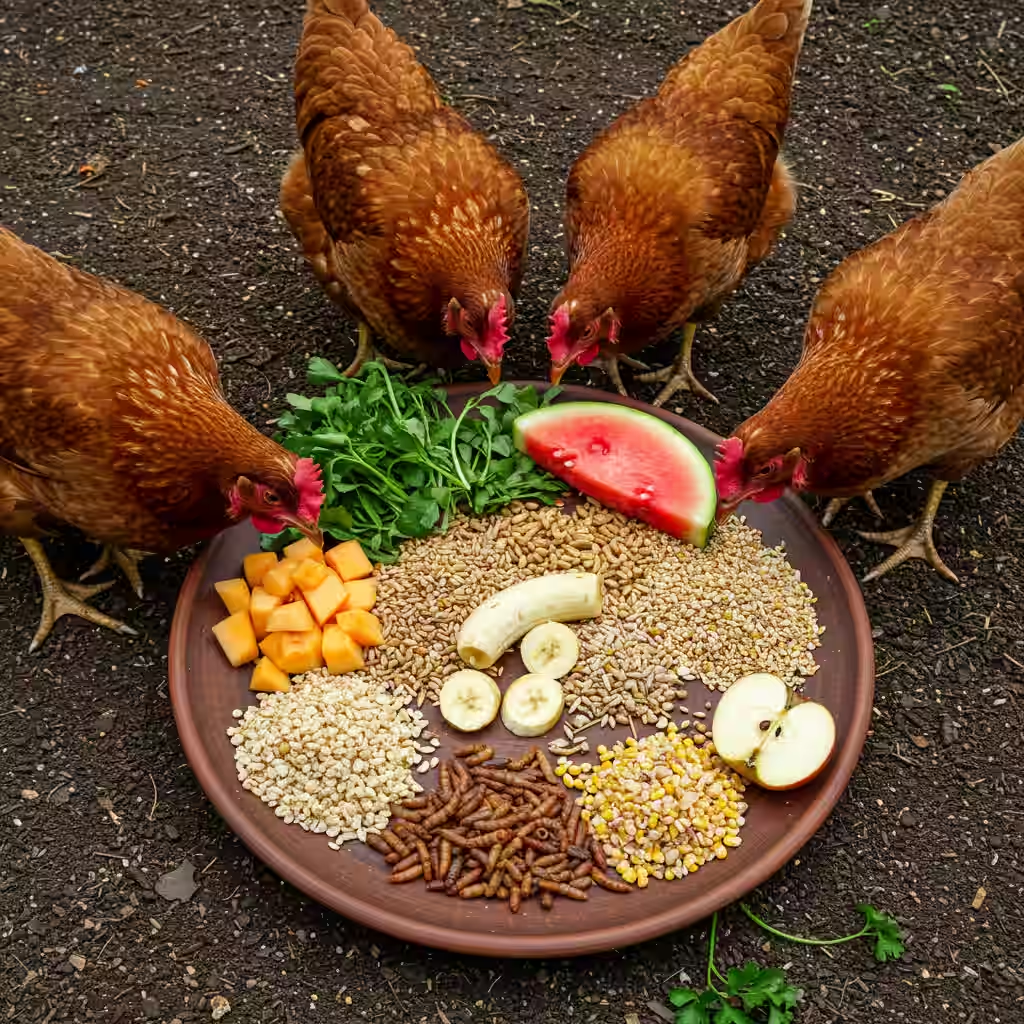Anyone who has spent time watching chickens forage knows these birds are far from picky eaters. Their natural scratching, pecking, and hunting behaviors reveal an opportunistic approach to nutrition that served their jungle fowl ancestors well for thousands of years. However, within this broad palate, chickens definitely show preferences for certain foods that backyard flock owners can leverage to improve health, happiness, and even egg production.
This comprehensive guide explores the foods that consistently rank as chicken favorites across different breeds and environments, while providing practical advice for incorporating these treats into a balanced feeding program. Whether you’re a novice chicken keeper or a seasoned poultry enthusiast, understanding your flock’s natural preferences can enhance your chicken-keeping experience.
The Science Behind Chicken Food Preferences
Before diving into specific favorite foods, it’s worth understanding why chickens prefer certain items over others. Their preferences are shaped by several factors:
Evolutionary Instincts
Chickens are descendants of the Red Junglefowl from Southeast Asia, birds that evolved as omnivorous foragers with a knack for finding nutritious foods in diverse environments. Their ancestors spent days scratching through forest floors searching for seeds, fruits, insects, and vegetation—establishing preferences that remain hardwired in modern chickens.
Sensory Perception
While chickens have only about 340 taste buds (compared to humans’ 9,000+), they compensate with other sensory adaptations:
- Color Vision: Chickens see in color and are particularly attracted to red, orange, and yellow foods.
- Texture Sensitivity: They prefer foods with varied textures that provide both immediate satisfaction and longer digestive engagement.
- Nutritional Wisdom: Research suggests chickens possess an innate ability to select foods containing nutrients their bodies currently need.
Social Learning
Chickens are highly social creatures that learn food preferences from watching flock mates. When one chicken discovers a delicious treat, others quickly follow suit, creating collective preferences that can develop within a specific flock.
Top Chicken Favorites by Category
1. Grains and Seeds: Energy-Dense Comfort Foods
If chicken treats were ranked by universal approval, grains would certainly top the list. These energy-rich foods tap into chickens’ natural foraging instincts while providing essential carbohydrates.
Cracked Corn: The Ultimate Chicken Comfort Food
Cracked corn consistently ranks as a chicken favorite across different breeds and environments. What makes this simple grain so irresistible to chickens?
- Natural Sweetness: Corn contains natural sugars that chickens can taste and enjoy.
- Energy Density: The high caloric content makes corn especially attractive, particularly in colder weather when chickens need extra energy for warmth.
- Perfect Size: Cracked corn provides the ideal particle size for chickens to peck and manipulate with their beaks.
- Visual Appeal: The bright yellow color attracts chickens’ sharp color vision.
Serving Suggestion: Scatter a handful of cracked corn in the chicken yard during late afternoon as an activity that also provides energy for the cooler night hours.
Other Beloved Grains
While corn might be the headliner, chickens enthusiastically consume a variety of grains:
- Wheat: High in protein and readily accepted by most flocks.
- Barley: Contains beneficial fiber and lower in calories than corn.
- Oats: Particularly good for winter feeding due to their warming properties.
- Millet: Smaller seeds perfect for engaging chickens’ precise pecking behavior.
Feeding Tip: Create a custom grain mix with seasonal variations—more corn in winter for energy, more wheat and barley in warmer months for lower-calorie nutrition.
2. Protein Sources: The Instinctual Favorites
While grains might get chickens excited, nothing compares to the frenzy that ensues when protein-rich foods become available.
Insects and Worms: The Ultimate Prize
Watching chickens chase a grasshopper or compete for worms reveals their true nature as insectivores. This protein source represents their evolutionary preference:
- Mealworms: Perhaps the ultimate chicken treat, dried mealworms cause immediate excitement in nearly any flock.
- Earthworms: The ultimate natural prize for a foraging chicken.
- Crickets: Another high-value protein source that chickens will chase enthusiastically.
- Black Soldier Fly Larvae: Extremely nutrient-dense and increasingly available as a sustainable protein source.
Natural Nutrition: Insects provide not just protein but a perfect balance of fats, amino acids, and micronutrients that commercial feeds often try to replicate through additives.
Feeding Strategy: Reserve insect treats for training, enrichment, or times when extra protein is beneficial, such as during molting or cold weather recovery.
3. Fresh Vegetables: Nutritional Powerhouses
Vegetables provide essential vitamins, minerals, and hydration that chickens instinctively seek out.
Leafy Greens: Consistent Favorites
Chickens show strong preferences for dark, leafy greens with these ranking consistently high:
- Collard Greens: Tough enough to withstand pecking while providing excellent nutrition.
- Spinach: Rich in iron and highly attractive to most chickens.
- Swiss Chard: The colorful stems particularly attract chicken attention.
- Kale: Nutrient-dense and holds up well in the chicken yard.
- Lettuce: While less nutritious than darker greens, its high water content makes it refreshing for chickens, especially in hot weather.
Interactive Feeding Idea: Hang whole leaves or bunches of greens at chicken eye level to create a tetherball-like treat that encourages exercise and prevents greens from becoming soiled.
Other Vegetable Favorites
Beyond leafy greens, chickens enjoy:
- Cucumber: High water content makes this refreshing in summer.
- Squash: Both summer and winter varieties (cooked) are readily consumed.
- Peas: Fresh or frozen, the bright color attracts immediate attention.
- Cabbage: When hung whole, provides hours of pecking entertainment.
Nutritional Note: The varied colors in different vegetables provide a spectrum of carotenoids and other phytochemicals that enhance egg yolk color and nutritional value.
4. Fruits: Sweet Seasonal Treats
Fruits tap into chickens’ preference for sweet tastes while providing valuable vitamins and hydration.
Chickens’ Fruit Favorites
- Watermelon: Perhaps the ultimate summer chicken treat, providing hydration, sweetness, and entertainment as they peck through the flesh to the seeds (which they also enjoy).
- Berries: Strawberries, blueberries, and raspberries are eagerly consumed, with the bright colors proving irresistible.
- Apples: Cut into chunks to prevent choking, apples provide long-lasting pecking opportunities.
- Bananas: The soft texture and sweetness make these a consistent hit.
- Melons: Cantaloupe, honeydew, and other melons follow watermelon in popularity.
Seasonal Benefit: Fruits with high water content like watermelon and cantaloupe serve a dual purpose in hot weather, providing both nutrition and hydration.
Feeding Caution: While fruits are healthy treats, their high sugar content means they should be offered in moderation—comprising no more than 10% of a chicken’s total diet.
5. Kitchen Scraps: Sustainable Favorites
Chickens excel at converting leftover food into eggs, making kitchen scraps both economical and environmentally friendly treats.
Top Kitchen Scrap Preferences
- Cooked Rice: The perfect size for pecking, most chickens love plain, cooled rice.
- Pasta: Unseasoned, cooked pasta provides an interesting texture chickens enjoy.
- Bread: Preferably soaked first to prevent crop impaction, bread is a traditional favorite.
- Cooked Beans: High in protein and readily accepted by most flocks.
- Meat Scraps: Small amounts of unseasoned, cooked meat are highly prized.
Implementation Tip: Designate a “chicken scrap container” in your kitchen for collecting acceptable leftovers, making it easy to bring a daily surprise to your flock.
Important Note: Avoid heavily salted, sugary, or fatty foods, as well as specific toxic items like avocado pits/skins, chocolate, uncooked beans, or onions.
6. Fresh Herbs: Medicinal Treats
Chickens show fascinating preferences for certain herbs, potentially driven by both taste and instinctive recognition of their medicinal properties.
Herb Highlights
- Parsley: Highly attractive to chickens and packed with vitamins.
- Cilantro/Coriander: Strong-scented and usually readily consumed.
- Basil: The aromatic qualities seem particularly appealing to many flocks.
- Mint: Some chickens develop a strong preference for various mint varieties.
- Oregano: Contains natural compounds that support immune function.
Dual-Purpose Benefit: Fresh herbs can serve as both feed supplements and coop fresheners when scattered in nesting boxes.
Growing Strategy: Plant a dedicated “chicken herb garden” near the coop for convenient fresh treats while keeping your culinary herbs separate.
7. Foraged Plants: Natural Delicacies
Chickens with access to pasture develop strong preferences for certain wild plants, with one standing out consistently.
Purslane: The Overlooked Superfood
This common “weed” is actually one of the most nutritious plants available and a true chicken delicacy:
- Nutritional Profile: Exceptionally high in omega-3 fatty acids (unusual for a plant), plus vitamins A, C, and E.
- Texture Appeal: The succulent, slightly crisp leaves are perfectly sized for pecking.
- Flavor Factor: The mild, slightly lemony taste appeals to chickens’ limited but specific taste preferences.
- Abundance: Grows readily in many climates, providing a free source of premium chicken food.
Identification Tip: Purslane has smooth, reddish stems with small, paddle-shaped succulent leaves, often growing in a flat, spreading pattern.
Other Forage Favorites:
- Clover: Both leaves and flowers are eagerly consumed.
- Dandelion: The entire plant from flower to root is nutritious and appealing.
- Chickweed: As the name suggests, a natural chicken favorite.
- Lamb’s Quarters: Another common “weed” that’s actually highly nutritious.
Implementing Favorites in a Balanced Feeding Program
While understanding chicken preferences helps improve flock happiness, responsible feeding requires balancing treats with proper nutrition.
The 90/10 Rule for Chicken Treats
Chicken nutrition experts generally recommend:
- 90% Commercial Feed: Complete layer or grower feed formulated for the appropriate life stage
- 10% Treats and Supplements: Including all the favorites discussed above
This ratio ensures chickens receive essential vitamins, minerals, and protein while still enjoying variety.
Strategic Treat Timing
When you offer treats can be as important as what you offer:
- Morning: Focus on protein-rich treats like insects if provided early.
- Midday: Fresh vegetables and fruits provide hydration during the hottest part of the day.
- Late Afternoon: Grains and seeds help provide energy for overnight temperature regulation.
- Special Times: Extra protein during molting, calcium supplements during heavy laying periods.
Creating Enrichment Through Favorites
Beyond basic nutrition, favorite foods can provide crucial mental stimulation:
- Scatter Feeding: Distributing small grains and seeds encourages natural scratching and foraging.
- Hanging Treats: Suspended cabbages or leafy greens create activity as chickens jump and peck.
- Treat Dispensers: Simple homemade devices that release foods gradually as chickens interact with them.
- Frozen Summer Treats: Embedding favorites in ice blocks provides cooling enrichment during hot weather.
Observing Your Flock’s Unique Preferences
While this guide covers universally popular chicken foods, individual flocks often develop unique preferences based on their specific genetics, environment, and experiences.
Conducting Preference Tests
To discover your chickens’ personal favorites:
- Offer small amounts of several different foods simultaneously
- Observe which are selected first and which generate the most excitement
- Note any differences between individual birds
- Keep a simple record to track seasonal changes in preferences
Adaptive Feeding
Use your observations to create a personalized treat strategy:
- Leverage Favorites for Training: Use the most prized treats for handling, coop training, or recall.
- Support Flock Hierarchy: Provide enough spread of treats that even lower-ranking birds get access.
- Address Individual Needs: Target specific nutrition to birds that might need extra support.
Conclusion: Happy Chickens, Healthy Eggs
Understanding and catering to your chickens’ food preferences does more than just make their days more enjoyable—it can significantly impact their health, productivity, and the nutritional quality of their eggs. By thoughtfully incorporating their natural favorites into a balanced feeding program, you create a win-win situation for both chickens and their keepers.
The vibrant orange-yellow yolks of eggs from chickens who enjoy a diverse diet rich in their preferred foods tell the story: when chickens eat better, we eat better too. Take time to observe what your particular flock loves most, and you’ll discover one of the most rewarding aspects of chicken keeping—the daily joy of watching your birds enthusiastically forage, scratch, and delight in the foods nature designed them to love.
Remember that while commercial feed provides the nutritional foundation, it’s the addition of these favorite foods that transforms mere subsistence into chicken culinary delight. Your reward will come in the form of healthier birds, more nutritious eggs, and the satisfaction of knowing you’re honoring the natural preferences of these remarkable birds.

